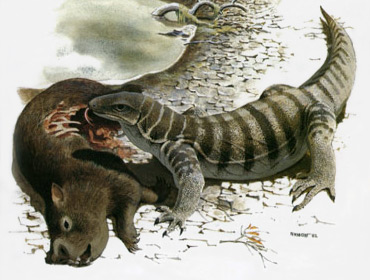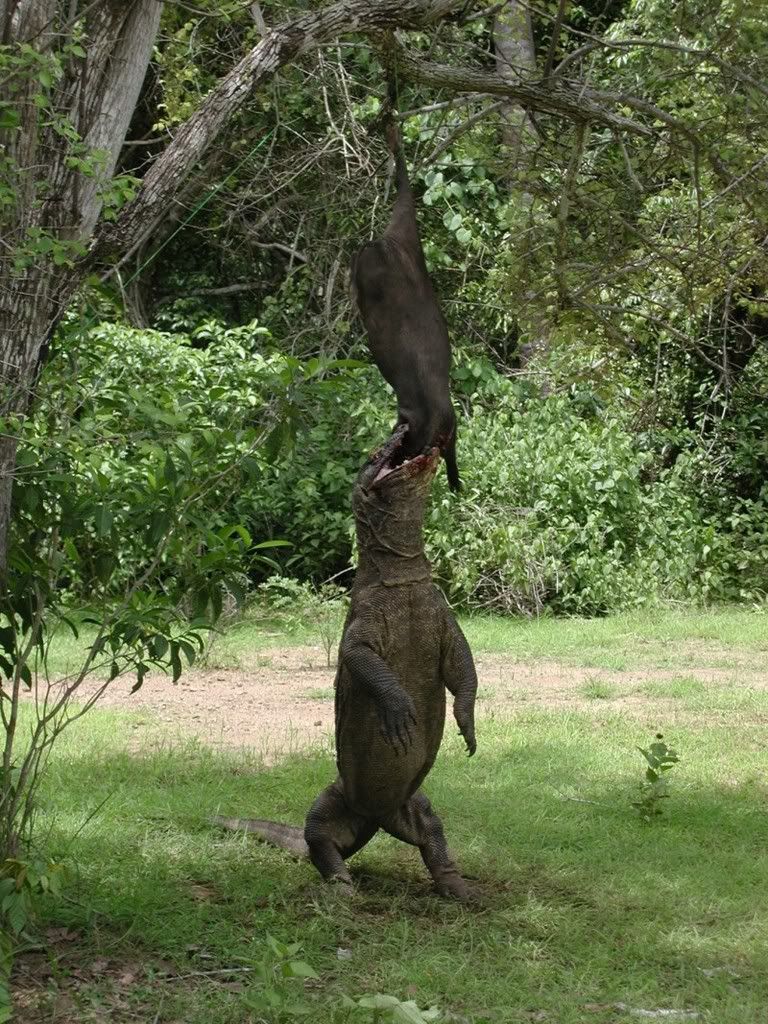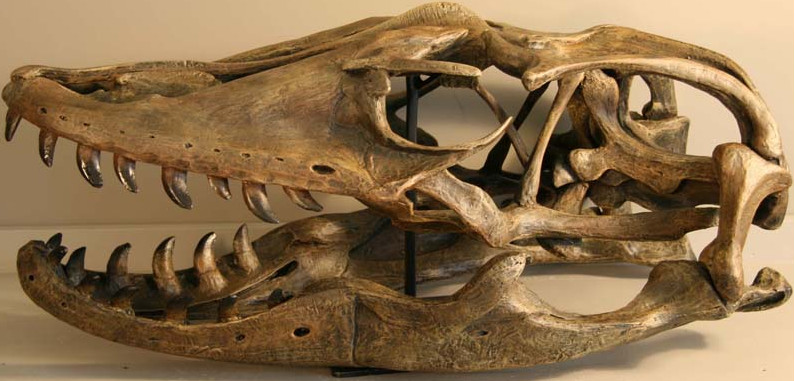 In this day and age, Australia is thought of as desert filled with eucalyptus trees and cotton plantations. The animals usually associated with this continent are koalas, kangaroo, wombats, and crocodiles, some of the largest to be found. There used to be other animals, commonly referred to as megafauna, that roamed this continent before being wiped out by plague or man. These were nightmarish versions of the creatures that we have today. Australia once held 10-foot tall kangaroos that fed on flesh rather than vegetation, and at one time had monitor lizards that dwarfed the
In this day and age, Australia is thought of as desert filled with eucalyptus trees and cotton plantations. The animals usually associated with this continent are koalas, kangaroo, wombats, and crocodiles, some of the largest to be found. There used to be other animals, commonly referred to as megafauna, that roamed this continent before being wiped out by plague or man. These were nightmarish versions of the creatures that we have today. Australia once held 10-foot tall kangaroos that fed on flesh rather than vegetation, and at one time had monitor lizards that dwarfed the  Komodo dragon. This was megalania prisca, a reptile reaching 30 feet in length and weighing at least 1,000 pounds or more. The Komodo dragon is roughly the size of a lion, but megalania was bigger than an average dairy cow. Extinct megalania is listed with the many casualties of the Ice Age. Or is it extinct? The creature has been sighted many times in the last century, and some sightings suggest that it lives also in New Guinea.
Komodo dragon. This was megalania prisca, a reptile reaching 30 feet in length and weighing at least 1,000 pounds or more. The Komodo dragon is roughly the size of a lion, but megalania was bigger than an average dairy cow. Extinct megalania is listed with the many casualties of the Ice Age. Or is it extinct? The creature has been sighted many times in the last century, and some sightings suggest that it lives also in New Guinea.Also believed to inhabit various parts of New Guinea, Megalania has been spotted many times throughout the years, but an equal number of skeptics maintain that the huge reptilian creature has long been extinct. Sightings have been reported as recently as the late Seventies, in which desert travelers discovered footprints in the sand, leading to apparent plaster casts of the creature's weighty impressions. Is that enough proof? We all know what thousands of plaster casts did to prove the existence of Bigfoot, don't we? Still, despite a lack of conclusive evidence, Bigfoot makes for good television. But when you're dealing with a giant lizard, that's must-see TV.
 During the middle of the day, a surveyor returned to his truck. Tired, he wanted nothing more than to go home. He spied what he thought was a fallen tree near his car. Blaming his fatigue for his lack of details he climbed in his car and slammed the door. The "log" suddenly bolted away! It ended up being a lizard of 15 feet in length. Australian cryptozoologist Rex Gilroy is convinced these creatures are still alive and it is only a matter of time before one is captured or killed and brought in.
During the middle of the day, a surveyor returned to his truck. Tired, he wanted nothing more than to go home. He spied what he thought was a fallen tree near his car. Blaming his fatigue for his lack of details he climbed in his car and slammed the door. The "log" suddenly bolted away! It ended up being a lizard of 15 feet in length. Australian cryptozoologist Rex Gilroy is convinced these creatures are still alive and it is only a matter of time before one is captured or killed and brought in.As recently as the late '70s there have been megalania sightings. In July 1979, Rex Gilroy was informed of footprints of the creature found in a recently plowed field. Across the field were 30 or so tracks from what looked like an enormous lizard. Rain had ruined most of the tracks but Gilroy was able to make a plaster cast of one that had been preserved. The footprint looked surprisingly like something that might have been made by a Megalania.
 Also in 1979 a sighting of megalania arose, this time by the best possible witness. Herpetologist Frank Gordon, after conducting some field work in the Wattagan Mountains in New South Wales, returned to his vehicle. After starting his engine he saw, what he at first thought was a log, scampering off. It ended up being a lizard of some 30 feet or more in length.
Also in 1979 a sighting of megalania arose, this time by the best possible witness. Herpetologist Frank Gordon, after conducting some field work in the Wattagan Mountains in New South Wales, returned to his vehicle. After starting his engine he saw, what he at first thought was a log, scampering off. It ended up being a lizard of some 30 feet or more in length.Another incident includes a farmer who observed a gigantic lizard walking along one of his fields. It walked along a wire fence, so the farmer used a set of fence posts as a guide. His estimate of the beast was a length of twenty to twenty-five feet. The size corresponds with megalania.
Megalania might not be constrained only to Australia--some sightings suggest it may live in New Guinea. A French priest in the 1960's was traveling up river with a native guide in order to reach his mission. During the trip he spotted a large lizard lying on a fallen tree in the sun. He told the native to stop, but being badly frightened, the native continued the journey. The priest returned to the spot the following morning and measured the tree. It was 40 feet long, yet the lizard almost matched it.
As mentioned, the creature is not simply contained to Australia, as further sightings have tracked it to New Guinea where in the Sixties, a French priest witnessed Megalania resting on a downed tree. It was later discovered that the creature's momentary wooded bed was over 40 feet in length, further adding to the mystery that such a gargantuan lizard does indeed exist. What about the hard evidence?
 Hard evidence has never stopped the imagination from seeing what we want to, nor has it disproved some of the world's great mysteries. If it did, we'd be able to reconstruct the Great Pyramids by hand. Without conclusive verification like the body of a deceased reptilian behemoth, Megalania will continue to remain the topic of strange Australian folklore. Although Megalania has been spotted many times by farmers and weary travelers, Megalania Prisca is indeed accounted for in the scientific community under the classification of extinct prehistoric species. Until one wanders out of the Australian Outback and into the bustling downtown core of Sydney in search of prey, we may never know what Megalania is truly capable of.
Hard evidence has never stopped the imagination from seeing what we want to, nor has it disproved some of the world's great mysteries. If it did, we'd be able to reconstruct the Great Pyramids by hand. Without conclusive verification like the body of a deceased reptilian behemoth, Megalania will continue to remain the topic of strange Australian folklore. Although Megalania has been spotted many times by farmers and weary travelers, Megalania Prisca is indeed accounted for in the scientific community under the classification of extinct prehistoric species. Until one wanders out of the Australian Outback and into the bustling downtown core of Sydney in search of prey, we may never know what Megalania is truly capable of.Whether or not megalania is still alive today is uncertain, but until a dead body, or perhaps a living one, is brought in we will forever find it in textbooks as an extinct animal of prehistoric times.
No comments:
Post a Comment